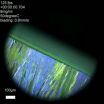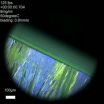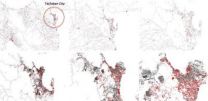(Press-News.org) VIDEO:
This is a high speed video of the crystal ribbons forming as the solution is spread using a squeegee like technique.
Click here for more information.
Sometimes engineers invent something before they fully comprehend why it works. To understand the "why," they must often create new tools and techniques in a virtuous cycle that improves the original invention while also advancing basic scientific knowledge.
Such was the case about two years ago, when Stanford engineers discovered how to make a more efficient type of thin, crystalline organic semiconductors. Their so-called "strained organic semiconductors" carried current faster than comparable systems, a big step toward producing flexible electronic devices that couldn't be built using rigid silicon chips.
Stanford Chemical Engineering Professor Zhenan Bao and her team dissolved organic molecules into a solution and deposited this liquid onto a flat surface. Their innovation was how they controlled the process through which those organic molecules assembled and crystallized as the liquid evaporated.
But Bao and her team wanted to understand why their process created such an electronically useful crystal lattice. The functionalities of any material are determined by how the building blocks are assembled and ordered. So they launched a new experiment with help from organic thin film characterization expert Dr. Aram Amassian, an Assistant Professor at King Abdullah University of Science and Technology (KAUST) in Saudi Arabia.
The process of crystallization normally occurs in the blink of an eye and the researchers needed to understand it at the nanoscale. To do this they had to create a way to record and visualize molecules as they formed crystals in slow motion.
In a paper published in Nature Communications, Professors Bao and Amassian reveal how they accomplished this feat: they combined a tiny, bright X-ray beam produced by the Cornell High Energy Synchrotron Source (CHESS) in Ithaca, New York, with high speed X-ray cameras to shoot a high speed movie showing how organic molecules form different types of ordered structures or crystals.
The paper explains why the Stanford process can produce such an ideal lattice – quick-evaporation of the solution coupled with the thinness of the liquid were part of the trick, but more surprises were in store. The researchers showed that once the liquid film becomes thin enough, also known as the confinement regime, the type of crystal can be selected with unprecedented control.
In a more far-reaching sense, the experiments reveal new ways to study and control crystallization, both of which will benefit other fields, such as pharmaceutical manufacturing, where the potency of pills can depend upon precisely controlling the crystal structure of active ingredients.
"This is an exciting paper because it represents an advance in instrumentation and methods with broad applicability in other fields, in addition to making an important finding for flexible electronics," said Gaurav Giri, first author of the paper.
Subtitle: The Squeegee Effect
Giri was a doctoral student in Bao's lab when the team first reported its new process for making fast organic semiconductors to Nature in December 2011.
In their initial paper, the Stanford engineers described how they applied a thin layer of solution to a heated surface. The solution contained organic semiconductor molecules that evaporated out of the solution and allowed the semiconductor to crystalize into a layer of crystals that could be used to make electronic circuits. They used a technique known as solution shearing to drag the thin layer of liquid across the surface, similar to how a window-cleaner uses a squeegee to clean glass.
In that first paper, Bao's team worked with Stefan Mannsfeld, a staff scientist at the Stanford Synchrotron Radiation Lightsource. He used X-ray scattering to reveal how the molecules in the crystalline layer lined up in a lattice that expedited electron flow.
But the Stanford engineers could not explain precisely why solution shearing packed the crystals into this beneficial structure, or polymorph. "We thought that understanding the mystery could lead to new developments and applications of our method," adds Bao.
Subtitle: A molecular dance
To accomplish their goal, the researchers had to understand how the molecules formed into a crystal as the solution evaporated.
They had some of the instrumentation required for the task. X-rays can reveal how molecules pack in a crystal much as dental X-rays can disclose the outlines of our teeth.
But teeth stay still during X-rays. Crystals grow and change rapidly. These crystals formed in milliseconds.
One key challenge was to record X-ray images of the molecular crystallization during the squeegee like process. Amassian and his team had to build a miniature squeegee that could be remotely operated in the safety of the X-ray hutch. Giri worked closely with Ruipeng Li, a postdoctoral fellow in Amassian's group, to integrate the solution-shearing set-up into the system. Amassian and Li had previously demonstrated X-ray movies of crystallization working with Dr. Detlef Smilgies, a scientist at CHESS.
To capture the growth process, the researchers used very bright X-rays produced by the synchrotron. They focused the synchrotron beam on a very small spot at the edge of the squeegee blade and fired it at intervals a few milliseconds apart as the squeegee dragged the thinning liquid until crystallization started.
Using a high speed X-ray camera they took snapshots of the molecular outlines revealed by the beam. Then they reassembled these snapshots to create an animated movie about the process of crystallization.
This had never been done before.
Subtitle: Movie with a plot twist
Watching the movies, the scientists found crystals forming in a highly unusual sequence. Crystals can take different forms. These are called polymorphs. The common form of any crystal is usually the most stable and should form last in a sequence of polymorph crystallization. But that was not the case with the crystals that were formed by the squeegee effect.
"We were stumped at first when the stable form appeared first at the air-liquid boundary, followed by other polymorphs," Amassian said. "This pointed to an unusual confinement effect possibly due to the thin liquid film trailing the squeegee."
The scientists confirmed their hypothesis by tuning the confinement conditions – thinning or thickening the liquid – to produce different polymorphisms. Giri discovered that solvents with different molecular sizes affected the formation of polymorphs. A Cornell team led by Professor Paulette Clancy helped with the computational analysis of the data.
Subtitle: Applications beyond semiconductors
Detailed knowledge of how to pack crystals with precise characteristics will help to make strained organic semiconductors more practical for use in new types if flexible electronic devices.
But the experiment will yield benefits beyond electronics and in other fields that require precise control over crystal polymorphism. Many drugs, for instance, are made from small molecules that must crystallize in just the right way to have the proper effect.
"We were of course pleased to demonstrate our initial hypothesis of confinement, but things got even more exciting when we showed the ease with which we could change the crystal formation within the confinement window," Amassian said.
INFORMATION:
Media contacts:
Tom Abate, Associate Director of Communications, Stanford Engineering, 1-650-736-2245, tabate@stanford.edu
Caitlin Clark, Science Writer, King Abdullah University of Science and Technology, T +966 (0)12 808 3338, Caitlin.Clark@KAUST.EDU.SA
About KAUST
King Abdullah University of Science and Technology (KAUST) is an international, graduate research university located on the shores of the Red Sea in Saudi Arabia. KAUST is dedicated to advancing science and technology through interdisciplinary research, education, and innovation. Fundamental and goal-oriented research is conducted by students, faculty, scientists, and engineers to address the world's pressing scientific and technological challenges related to water, food, energy, and the environment. http://www.kaust.edu.sa
Global scientific team 'visualizes' a new crystallization process
Scientists from KAUST and Stanford create a novel way to do time-lapse studies of crystallization that will lead to better flexible electronic displays, circuits, and possibly more effective drugs
2014-04-16
ELSE PRESS RELEASES FROM THIS DATE:
Researchers propose network-based evaluation tool to assess relief operations feasibility
2014-04-16
The United Nations Office for Disaster Risk Reduction reported that disasters have affected around 2.9 billion people worldwide from 2000-2012— killing more than a million, and damaging around 1.7 trillion US dollars in estimates. Moreover, natural disasters and their damages have been documented to occur with increasing intensity. Given the staggering numbers, effective disaster preparedness and relief response plans is compelling, especially considering the fact that natural disasters are usually unpredictable and damage cannot be avoided.
Implementing a speedy and ...
Medieval slave trade routes in Eastern Europe extended from Finland and the Baltic Countries to Asia
2014-04-16
The routes of slave trade in Eastern Europe in the medieval and pre-modern period extended all the way to the Caspian Sea and Central Asia. A recent study completed at the University of Eastern Finland suggests that persons captured during raids into areas which today constitute parts of Finland, the Russian Karelia and the Baltic Countries ended up being sold on these remote trade routes. There was a particular demand for blonde girls and boys who were seen as exotic luxury items, and it was financially beneficial to transport them to the far-away markets. The study by ...
Study provides new insight into how toddlers learn verbs
2014-04-16
Parents can help toddlers' language skills by showing them a variety of examples of different actions, according to new research from the University of Liverpool.
Previous research has shown that verbs pose particular difficulties to toddlers as they refer to actions rather than objects, and actions are often different each time a child sees them.
To find out more about this area of child language, University psychologists asked a group of toddlers to watch one of two short videos. They then examined whether watching a cartoon star repeat the same action, compared ...
Potential use of Google Glass in surgical settings
2014-04-16
Oxford, UK, April 15, 2014 – An article recently published in the International Journal of Surgery shows the potential applications for Google Glass in the surgical setting, particularly in relation to training.
Personal portable information technology is advancing at a breathtaking speed. Google has recently introduced Glass, a device that is worn like conventional glasses, but that combines a computerized central processing unit, touchpad, display screen, high-definition camera, microphone, bone-conduction transducer, and wireless connectivity.
The authors of the ...
Multiple births don't have to be an inevitable result of fertility treatments
2014-04-16
While fertility treatments have helped many people become parents, they commonly result in multiple births, increasing the risk of prematurity, and leading to lifelong complications. But this doesn't have to be the case, according to Yale School of Medicine researchers and their colleagues, who recommend sweeping changes to policy and clinical practice in a study published in the April issue of Fertility & Sterility.
Pasquale Patrizio, M.D., professor in the Department of Obstetrics, Gynecology & Reproductive Sciences at Yale School of Medicine, and his colleagues at ...
Ant colonies help evacuees in disaster zones
2014-04-16
An escape route mapping system based on the behavior of ant colonies could give evacuees a better chance of reaching safe harbor after a natural disaster or terrorist attack by building a map of showing the shortest routes to shelters and providing regular updates of current situations such as fires, blocked roads or other damage via the smart phones of emergency workers and those caught up in the disaster.
Koichi Asakura of Daido University in Nagoya and Toyohide Watanabe of the Nagoya Industrial Science Research Institute in Japan have carried out successful simulations ...
New Geosphere series: The St. Elias Erosion/Tectonics Project in Southern Alaska
2014-04-16
Boulder, Colo., USA – GEOSPHERE has added a new themed issue to its roster: "Neogene tectonics and climate-tectonic interactions in the southern Alaskan orogeny." Interest in Alaskan tectonics has varied over time, propelled mostly by geologic hazards. In 1964, the great Alaskan earthquake focused attention on Alaska and was a major factor in the establishment of the concept of subduction in the early days of plate tectonics.
In the 1980s, the northern Cordillera, including Alaska, was the subject of extensive study using the terrane analysis approach, which spawned ...
Diverse gene pool critical for tigers' survival, say Stanford scholars
2014-04-16
New research by Stanford scholars shows that increasing genetic diversity among the 3,000 or so tigers left on the planet is the key to their survival as a species.
Iconic symbols of power and beauty, wild tigers may roam only in stories someday soon. Their historical range has been reduced by more than 90 percent. But conservation plans that focus only on increasing numbers and preserving distinct subspecies ignore genetic diversity, according to the study. In fact, under that approach, the tiger could vanish entirely.
"Numbers don't tell the entire story," said study ...
UT Arlington physicist creates new nanoparticle for cancer therapy
2014-04-16
A University of Texas at Arlington physicist working to create a luminescent nanoparticle to use in security-related radiation detection may have instead happened upon an advance in photodynamic cancer therapy.
Wei Chen, professor of physics and co-director of UT Arlington's Center for Security Advances Via Applied Nanotechnology, was testing a copper-cysteamine complex created in his lab when he discovered unexplained decreases in its luminescence, or light emitting power, over a time-lapse exposure to X-rays. Looking further, he found that the nanoparticles, called ...
Using video surveillance to measure peoples' hand washing habits
2014-04-16
One of the best defenses against infectious disease is one of the most simple – hand washing.
Still, despite years of global public awareness campaigns, hand washing rates remain low. Caregivers of young children in low-income, developing world settings are found to wash their hands only 17 percent of the time after using the toilet.
A new study finds that video surveillance can provide insights into hand washing behavior. When another person is present, for example, hand washing rates increase 23 percent. These findings could, in turn, inform the design, monitoring ...
LAST 30 PRESS RELEASES:
Numbers in our sights affect how we perceive space
SIMJ announces global collaborative book project in commemoration of its 75th anniversary
Air pollution exposure and birth weight
Obstructive sleep apnea risk and mental health conditions among older adults
How talking slows eye movements behind the wheel
The Ceramic Society of Japan’s Oxoate Ceramics Research Association launches new international book project
Heart-brain connection: international study reveals the role of the vagus nerve in keeping the heart young
Researchers identify Rb1 as a predictive biomarker for a new therapeutic strategy in some breast cancers
Survey reveals ethical gaps slowing AI adoption in pediatric surgery
Stimulant ADHD medications work differently than thought
AI overestimates how smart people are, according to HSE economists
HSE researchers create genome-wide map of quadruplexes
Scientists boost cell "powerhouses" to burn more calories
Automatic label checking: The missing step in making reliable medical AI
Low daily alcohol intake linked to 50% heightened mouth cancer risk in India
American Meteorological Society announces Rick Spinrad as 2026 President-Elect
Biomass-based carbon capture spotlighted in newly released global climate webinar recording
Illuminating invisible nano pollutants: advanced bioimaging tracks the full journey of emerging nanoscale contaminants in living systems
How does age affect recovery from spinal cord injury?
Novel AI tool offers prognosis for patients with head and neck cancer
Fathers’ microplastic exposure tied to their children’s metabolic problems
Research validates laboratory model for studying high-grade serous ovarian cancer
SIR 2026 delivers transformative breakthroughs in minimally invasive medicine to improve patient care
Stem Cell Reports most downloaded papers of 2025 highlight the breadth and impact of stem cell research
Oxford-led study estimates NHS spends around 3% of its primary and secondary care budget on the health impacts of heat and cold in England
A researcher’s long quest leads to a smart composite breakthrough
Urban wild bees act as “microbial sensors” of city health.
New study finds where you live affects recovery after a hip fracture
Forecasting the impact of fully automated vehicle adoption on US road traffic injuries
Alcohol-related hospitalizations from 2016 to 2022
[Press-News.org] Global scientific team 'visualizes' a new crystallization processScientists from KAUST and Stanford create a novel way to do time-lapse studies of crystallization that will lead to better flexible electronic displays, circuits, and possibly more effective drugs



